The transformation of the Future of Healthtech has been accelerated within a span of a few months due to the outbreak of contagion. The healthcare sector has been working hard and bringing forth some notable radical shifts in recent years. Technological innovations and the booming startup ecosystem are disrupting the healthcare sector. The sector has introduced new models of treatments and diagnosis catering to the needs of the patients. The article delineates how the healthcare industry has attained unimaginable heights despite certain challenges.
The Future of Healthtech is challenged in recent times by the pandemic coronavirus. The outbreak has triggered several to be indoors. Be it work or shopping, everything from the bedroom or the living room. You need to go for a health check-up, what will you do then? The doctors and nurses cannot come to your doorsteps, can they? Download the app “mfine” and get your health check-up at home. This is possible now in the emerging age of Healthtech. The major factors driving the innovation in the Future of Healthtech are:
- The explosion of online platforms
- The growing number of healthcare startups
- Tech-enabled healthcare equipment
- Rising health awareness
- Increasing literacy
- Rising of per capita income
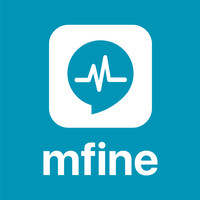
Being a developing country in the 21st century, India has faced certain problems like lack of proper healthcare facilities in rural areas, cost-effective healthcare facilities, inadequate government spending and support and healthtech penetration in the rural areas. And all these obstacles have actually paved the path for innovation in healthtech with an aim of providing quality assured service.
The future of healthtech is trying hard to make itself cost-efficient and build scalable healthcare technology. The Indian healthtech is the 4th largest contributor in the expansion of the technocentric start-ups in the nation.
As per the data of Traxcn in 2018, Indian healthtech gained an investment of total $571 million. And the number shows promising in the years to come. In 2019, NASSCOM collaborated with GE Healthcare to drive the expansion of startups and boost healthcare solutions. It is materialized with the help of technologies like Artificial Intelligence (AI), Machine Learning (ML), Nano-tech, IoT, 3D printing etc.
There are about 3000 startups in the healthtech sector. Some of the popular names being PharmEasy, CureFit, Practo, MedLife, CallHealth etc. The ratio of doctors and medical practitioners to patients is at present 1:1596. Whereas, the World Health Organization (WHO) suggests that the ratio should at least be 1: 1400.
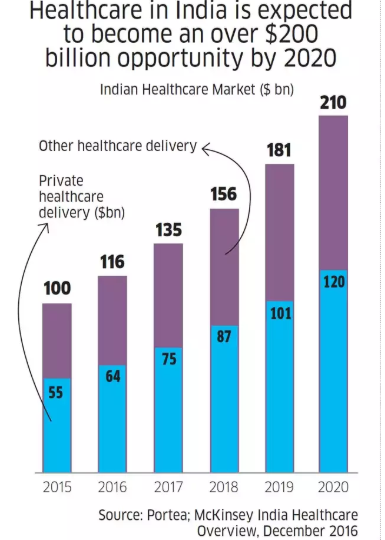
Booming Healthtech startups
The healthtech startups in India are catering to several broad categories like pharmacy, home healthcare, biotech, doctor’s consultation and appointments etc. According to McKinsey, by 2025 Indians can save about $10 billion through the application of telemedicine instead of direct consultation with doctors that happen in person. Just like the Yin-Yang theory, the fast-paced healthtech sector is hinting at some red flags. That must be taken into consideration while democratizing the healthcare facilities as the digital transmission of personal health information can be dangerous.
Unlike Fintech, the healthtech is a bit more unstructured. Questions often arise regarding the safety of technology in the health care domain. It is still without the presence of established protocols, legislation and quality assurance. It is still at a stage of infancy with a huge scope of improvement.
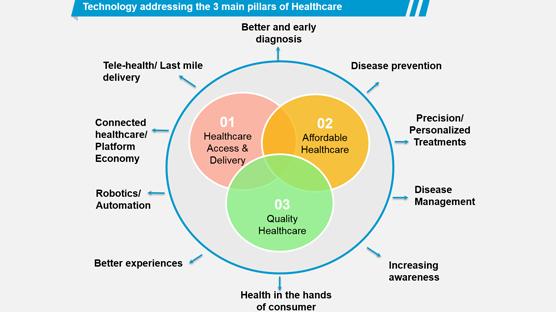
The healthtech development in India can be categorized under three heads,
- firstly the use of technology in the healthtech startups as mentioned above,
- secondly, the use of technology which helps the doctors treat their patients like diagnosis, image processing, image analysis, therapy, anomaly detection, etc
- thirdly using technology for maintaining ancillary responsibilities, like data management, handling operations and systems in an organization etc.
- As per NASSCOM report, 60% of the focus is given on the last point by the healthtech startups, regarding better health information management, personal health solutions, etc while 40% of the focus is on tech-enabled treatment procedures and diagnosis.
The emerging healthtech has witnessed reluctance in the doctors in relying completely on the technology-driven reports and suggestions. Many are not aware of the fast-developing technology. Many are not comfortable with the technological inclusion in the age-old traditional methods, for example treating a patient relying completely on the AI.
Just like the IT sectors, healthtech is also facing automation, reducing human intervention in every passing day. But technology can never replace or substitute the doctors and the medical practitioners. What they can or is doing is assisting the doctors in improving the quality of the medical treatments.
Disruptions in Healthtech
Even though there are certain roadblocks, the picture of the ubiquitous healthtech is a pretty bright one. According to 15-country Future Health Index (FHI), about 76% of healthcare professionals and medical practitioners are embracing digital technology and 46% usage of Artificial Intelligence (AI) is also observed in the domain.
According to the President of Philips Healthcare-Indian Subcontinent, Rohit Sathe, “Philips’ Future Health Index 2019 report confirms that digital health technology is a pivotal pillar in delivering value-based care across the healthcare continuum in India. Tools including telehealth and adaptive intelligence solutions can help lower the barriers between hospitals and patients, thereby improving access to care and enhancing overall patient satisfaction, particularity in tier II & III cities in India. We hope that the insights from this report will assist key stakeholders in designing and implementing robust and sustainable health systems in the country.”
It is observed that when the Indian healthcare industry is using the technological advances, the overall medical experiences improve, both for the doctors as well as the patients. The Department of Health Research (DHR) under the Government of India has positively affected in the quality of healthcare (90%), healthcare professional satisfaction (89%) and patient outcomes (70%).
As per a report by Royal Philips, above 60% of doctors believe that patients having access to their medical reports, test results, prescriptions, and other personal health data show an overall improvement in their experiences and general well being. With internet penetration and affordable data charges rising in full swing, about two-third of Indians feel comfortable in acquiring medical advice through the medical apps in their phones. This shows their adaptability to the technological disruption occurring in the healthtech sector of the country.
Technology like AI, Machine learning and Blockchain has been invaluable to the growing healthtech in India. The notable Indian startup mfine uses Assistive Intelligence platform which is used by the doctors to acquire a preliminary prognosis based on the data provided by the patients.
According to The Center for Internet and Society (CIS India), the application of Artificial Intelligence can be predictive, prescriptive or descriptive. AI is used in predicting and spotting changes in health conditions of the patients. Mfine can be the best example of such an application. Healthtech has impacted the development of Image Processing or Medical Imaging, thus improving the quality of the diagnosis.
Hi-tech tools for Healthcare professionals
Image Processing or Medical Imaging is the scientific technique of forming visual representations of the interior parts of the body which lies under the skin for clinical analysis and intervention. Image processing includes Magnetic Resonance Imaging (MRI), Medical Ultrasound, Endoscopy, Position Emission Tomography (PET), X-ray radiography etc.
These visual representations help the doctors and scientists to address the symptoms better and start the required medical procedures. The scientific technology behind Medical Image Processing is developing every single day. And the Diagnostic Industry needs AI-driven software for doing the rest of the duties. The software and the machines will capture the images. And the AI will be an aid in the analysis of abnormalities as detected by the Image processing.
For treating cancers, AI will use specially formulated algorithms to measure the probability of a tumour of being benign or malignant. This will help the doctors and medical professionals to make the right decisions about the ongoing treatment.
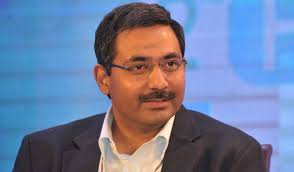
In 2018, the chief information officer of Apollo Hospitals Mr. Arvind Sivaramakrishnan said “It is all coming together in realizing our vision of connected health. We are using technology to ensure that the patient and the health system are well-connected. When I say the health system, I also mean the support services that help our operations deliver better efficiency.”
The 70-year-old chain of Apollo Hospitals uses technological tools like analytics, Electronic Medical Record (EMR), Personal Health Record (PHR), hybrid cloud computing models, and mobility applications for consistent and improved monitoring of the medical outcomes. Several private hospital chains like Fortis, Manipal, Narayana Health emphasizes on the use of Information Technology (IT), thus following the global healthcare standards of Mayo Clinic, Massachusetts General Hospital etc.
Technology for patients
The application of AI and Bots can also be seen in the Touchkin Services. A Bangalore based healthtech start-up that has launched Wysa. Its a chatbot app created for providing mental health support to the patients and transferring important cases to doctors. The introduction of tele-medicines, remote consultations, cheaper and efficient medical devices and equipment, and accessible healthcare facilities has unleashed the potential of the growing healthtech in India.
The Arvind Eye Hospital uses a cost-efficient glaucoma screening tool ICare Tonometer with Electronic Health Record (EHR) system for treating visual impairment in the rural areas. Sankara Eye Center of Bangalore has initiated a joint project with Bonn’s Eye Clinic of Germany for building an alternative camera attachment with LED light and battery that can serve as a cheap and efficient smartphone-based ophthalmology device.
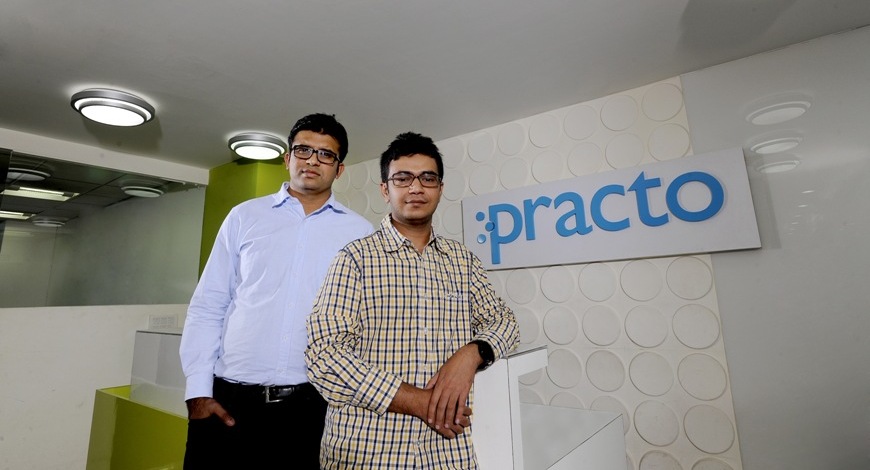
Several hospitals and healthtech start-ups have recognized the potential of smartphones and online platforms. This is crucial for better access to healthcare facilities and also for connecting doctors with patients. Companies like Practo, Lybrate, Portea, iCliniq help in remote diagnosis and monitoring of patients, and provision of required medical facilities through home visits.
Sites like MUrgency help in tackling emergency situations by connecting with doctors, nurses, ambulances, first aids etc. Apart from these, there are smartwatches and Fitbits that allow continuous monitoring of internal functions like blood pressure, heartbeats, pulse rates etc. Samsung’s GearFit can track GPS, footsteps, heartbeat rates; Apple’s Watch Series 4 offers electrocardiographic support and saving it in a sharable PDF format.
Innovative Data Management
The Internet of Medical Things (IoMT) is used by several hospitals to monitor the vital signs of the patients like body temperature, blood pressure, respiration etc. Virtual Reality and 3D printing technologies are used for training purposes and reducing the chances of failures in surgeries.
In the healthcare sector Blockchain technology needs a special mention as it helps in systematic data management and ensures data security. It is also used in supply chain management for securing transportation of drugs and avoiding tackle with theft in transit. Call Health (healthtech platform) in partnership with ThynkBlynk (Blockchain services) has taken several steps to monitor fraud documentation and repeated pathological tests, verification of documentation etc.
Besides, start-ups and hospitals, the Indian pharmaceutical sector is applying developed technological tools for improving the medical facilities like effective medicines and drugs for treating ailments. The machines manufacturing the medicines, the equipment of diagnosis and medical procedures, doctors, patients, start-ups, everything falls under the Healthtech ecosystem.
Wrap Up
India is witnessing technological disruption in all the sectors, like Fintech, Edtech, amidst this fast movement, the strict laws and regulations are needed to govern the domain of healthtech. The regulatory laws must be such that the scope of innovation is not hampered.
As of now, India is on a journey of making a dominant position in the global healthtech sector. Several ventures and partnerships are taken by organizations like hospitals and start-ups to improve the overall healthcare facilities of the country.
Majority of the population is hailing from the rural and semi-urban areas, technology is used to create a harmony between the effective and quality assured medical facilities and price-sensitive user base of the nation.

